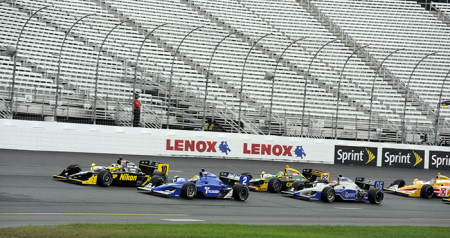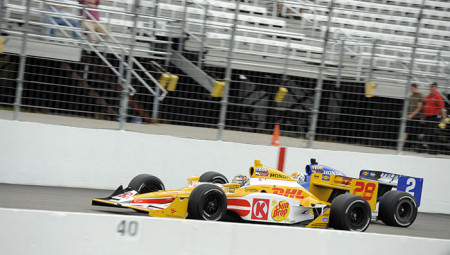The Way It Is/ Building an audience in New England
by Gordon Kirby Last week's IndyCar race at New Hampshire Motor Speedway will be talked about for years to come but, sad to say, the race did not help Indy car racing's struggle for credibility. Unfortunately, the finish of the race was a travesty, resulting in protests from Newman/Haas and Target/Ganassi teams to be heard on Tuesday in Indianapolis with NHMS boss Jerry Gappens and highly-experienced USAC racing men Rollie Helmling and Jeff Stoops presiding.
Last week's IndyCar race at New Hampshire Motor Speedway will be talked about for years to come but, sad to say, the race did not help Indy car racing's struggle for credibility. Unfortunately, the finish of the race was a travesty, resulting in protests from Newman/Haas and Target/Ganassi teams to be heard on Tuesday in Indianapolis with NHMS boss Jerry Gappens and highly-experienced USAC racing men Rollie Helmling and Jeff Stoops presiding.
Newman/Haas has no doubt that Oriol Servia won the race and Ganassi's team wants the results declared after 220 laps rather than five laps earlier. That would mean Will Power would be classified as low as fourteenth rather than fifth, a difference of as many as 14 points that could be critical in the Franchitti-Power championship battle.
Race fans in New England hoped the revival of Indy car racing at NHMS after a thirteen-year absence would draw a reasonable crowd and produce some good racing. Many people fondly recalled the spectacular 1993 duel at the track between Nigel Mansell and Paul Tracy and hoped to see more of the same.
But IndyCar is all-but invisible in the New England media and we knew it was going to be an uphill struggle to draw much of a crowd. Jerry Gappens and his staff worked hard to promote the race and the local media did a great job providing plenty of coverage in the week of the race. But as expected the crowd was modest at best although it was good to see that many were fans new to NHMS.
Prior to the mad comedy at the end, the race itself could not have been better with plenty of fierce racing and passing. Dario Franchitti dominated the day until Takuma Sato collided with him, but behind Dario there was action aplenty as the drivers showed it was possible to pass despite the track's narrow groove. It was much better than your typical NASCAR race at NHMS and a great advertisement for IndyCar until the disastrous attempt to restart the race with ten laps to go amid light, misting rain.

© Gary Gold
On raceday morning in New Hampshire Randy Bernard held a press conference to confirm, among other things, the delay until 2013 of the much-discussed 'aero kits'. Bernard freely admitted it was a financial decision and his comments underlined the commercial difficulties facing IndyCar's teams.
"No one is more disappointed than I am that we're not going to do it," Bernard said. "But we need to look at the longterm future of the sport and we feel that it's very important that we are listening to the team owners as much as possible on this one. We don't want to see our car counts go from 26 and 27 down to 16 because of an aero kit. The manufacturers and team owners have told us it's very expensive."
Michael Andretti told me he is concerned that a handful of the smaller teams will not be able to afford the new cars and engines required for IndyCar's 2012 formula. Michael says IndyCar's biggest problem is its poor TV ratings and he believes Bernard should have focused on finding a way to broaden the TV audience rather than going to a new car.
"In my opinion we shouldn't have jumped to a new car," Andretti said. "Why are we doing that when nobody can watch us? I think we should wait until everyone can watch us and then do something different with the car. I think our field's going to be weak next year. We may have only 16 or 18 cars. I'll be surprised if we run four cars next year. We're hurting and I know a lot of other teams are hurting."
Michael thinks IndyCar should have kept the current car with altered bodywork for a few more years and made the move next year to new engines only.
"I think they should have just gone with the new engine manufacturers," he said. "That's a good story in itself and maybe they could have changed the look of this car we have now. Because this car is so cheap to run the teams would have been able to scrape the money together to get there if they had kept this car. But now you've got to buy everything new and that's tough for most teams."
However, IndyCar is committed to its course and the top teams have scheduled busy winter testing programs as soon as the new cars are available following the series of prototype tests with Bryan Herta's team. Aero kits aside, the die is cast for next year's new formula and it will be interesting and critical to see how many teams and cars make it to the track next season.

© Gary Gold
To make the race successful IndyCar will have to work hard with Gappens to increase media coverage of all the other Izod IndyCar Series races and the overall awareness of Indy car racing in general in New England. In today's world this is no small job requiring concerted, ongoing effort.
For their part, the drivers enjoyed the challenge of racing at NHMS and provisional winner Ryan Hunter-Reay raved about the track.
"Man, the racing was so difficult with the traffic," Ryan said. "You had to time it just perfect and it was a lot of fun. This track is a lot of fun. If I had it my way we'd be coming back here for many years to come. Hopefully, that's the case. All the drivers really respect this place. They'll tell you this is one of the toughest ovals they've been on in their life."
Third-placed Scott Dixon agreed.
"There was a lot of action on the track," Scott said. "The racing was good. It was tough. There was lots of passing. It was all happening all the time. For me, at about lap 200 it felt like we were 500 miles in already. I think we put on a good show. It was a little confusing at the end but, all in all, I thought it was a hell of a race."
Minus the disputed finish, IndyCar needs more oval races like we saw in New Hampshire. In fact the race emphasized the point that flat, one-mile tracks are the best ovals for Indy cars. Dario Franchitti has said repeatedly, as he did again in this space last week, that high-banked 1.5-mile and 2.0-mile ovals are not compatible with Indy cars. They don't produce good racing and when they do it's extremely dangerous.
Over the years many different formulae and variations have been tried without success by USAC, CART, Champ Car and IRL/IndyCar to find a formula that works on high-banked tracks. Fact is, high-banked tracks are for stock cars not Indy cars. Bill France Sr. built Daytona as a trioval with high banks to produce record speeds for stock cars, faster than those turned by USAC's Championship cars at the comparatively flat, four-cornered Indianapolis Motor Speedway. The concept works perfectly well for stock cars and today NASCAR's drivers love their high-banked tracks and loath flat tracks like New Hampshire.
Unfortunately, more and more high-banked tracks have been built over the years although given NASCAR's dominance of the market I guess that was the right thing to do. But it leaves IndyCar with few options to explore when it comes to ovals. There's Milwaukee, New Hampshire and Phoenix but the latter, owned these days by ISC, is unlikely ever to host an IndyCar race which means every effort should go into making Milwaukee and New Hampshire successful.
It's also important for IndyCar to have a foothold and identity in the northeast as a whole. I believe Randy Bernard and his people need to make a commitment to build New Hampshire into a successful race and to rebuild Milwaukee because it's such an historic event as well as being the right kind of track for Indy cars. In the long run I believe both of these one-mile ovals can be essential components in IndyCar's re-creation. But it's going to take belief and a longterm commitment from IndyCar to make it happen.
Auto Racing ~ Gordon Kirby
Copyright 2011 ~ All Rights Reserved
Copyright 2011 ~ All Rights Reserved
Top of Page